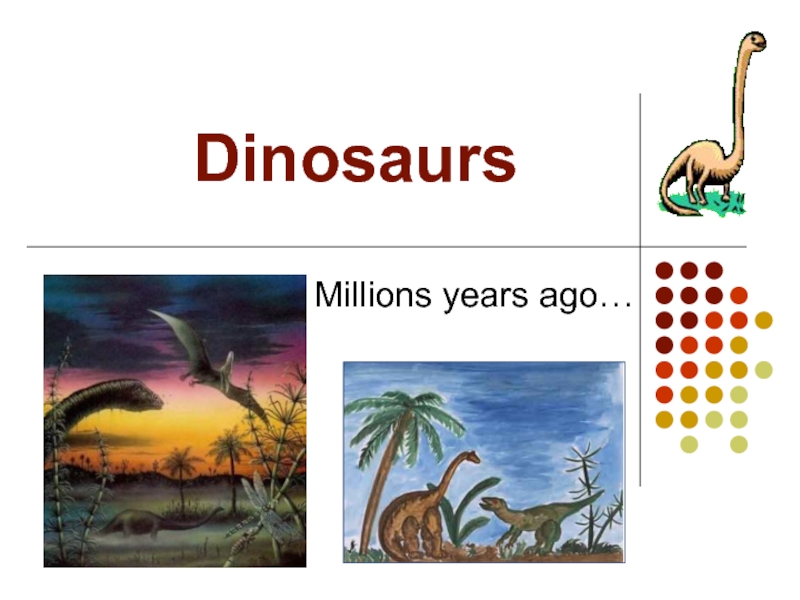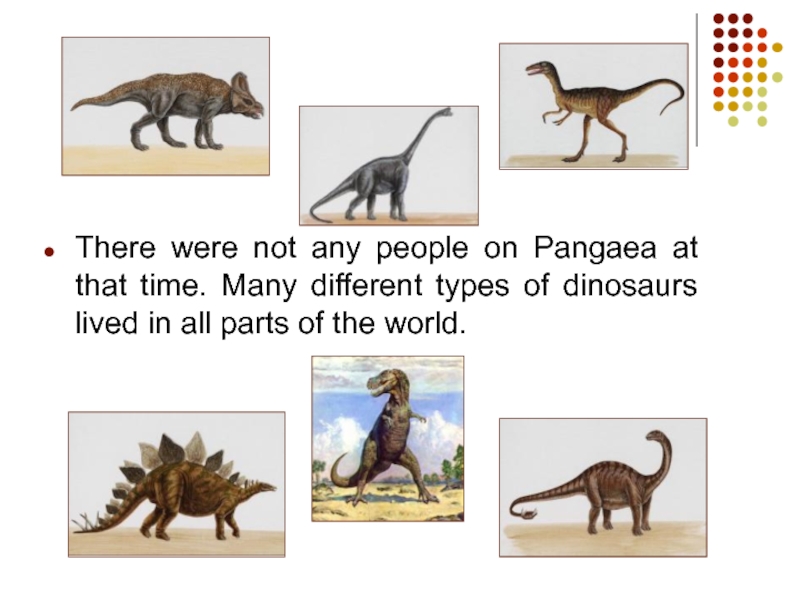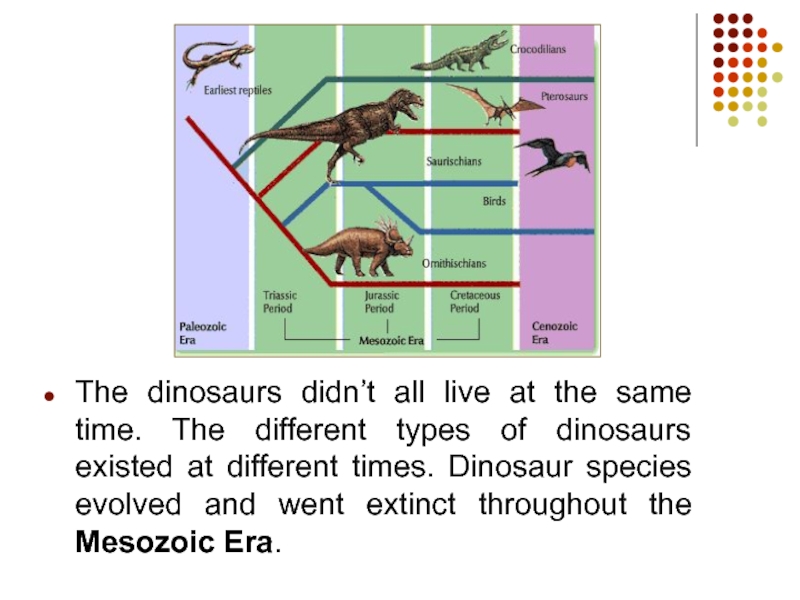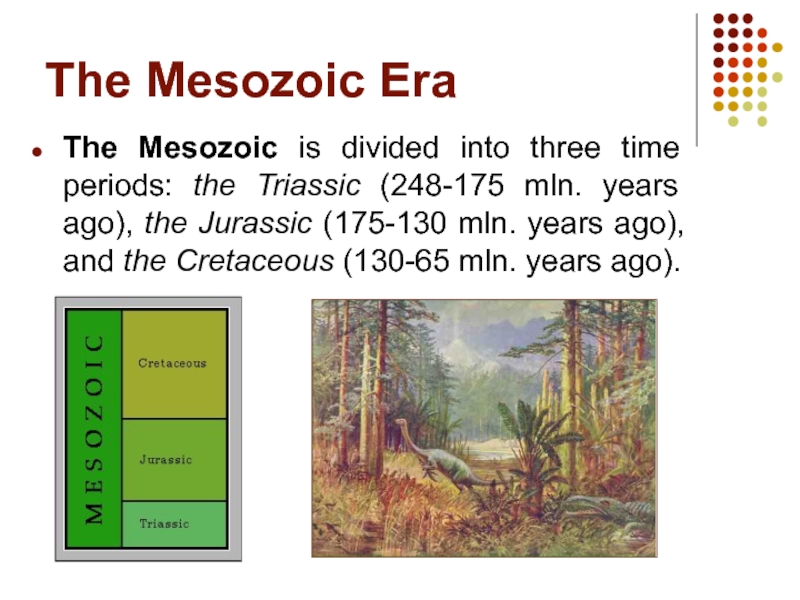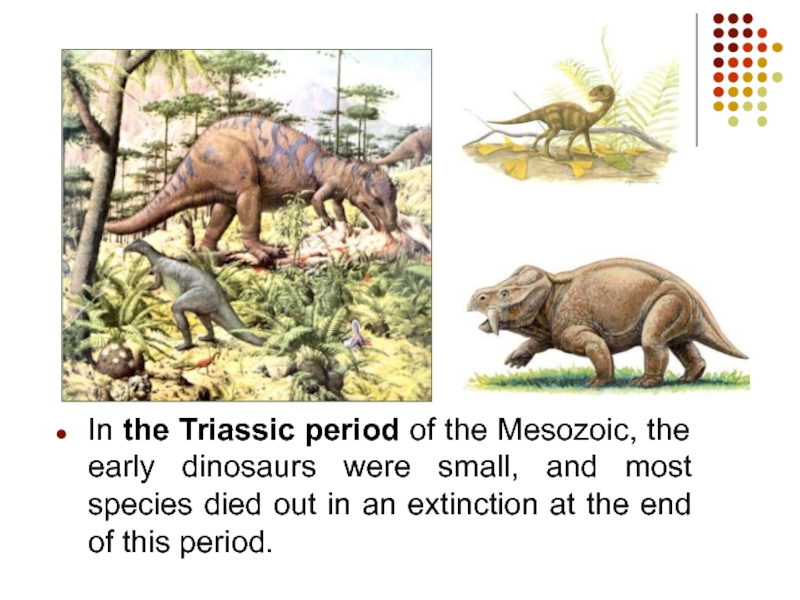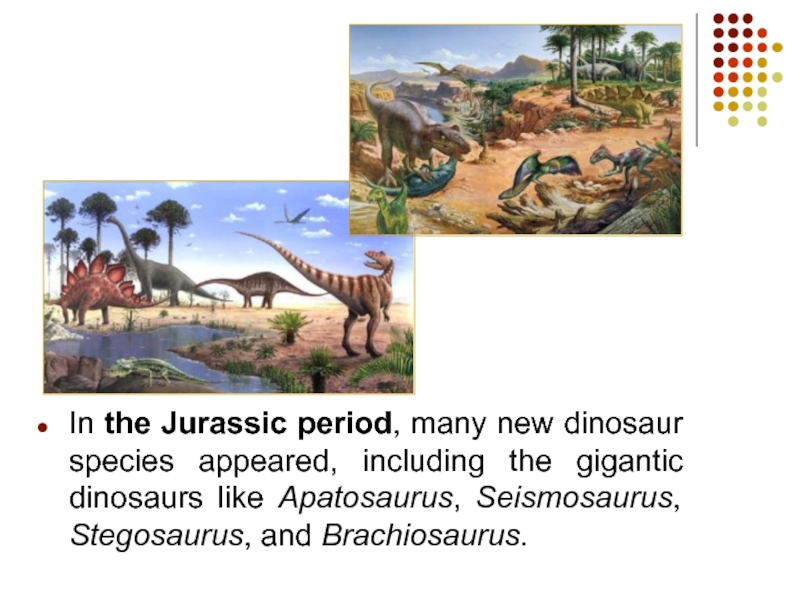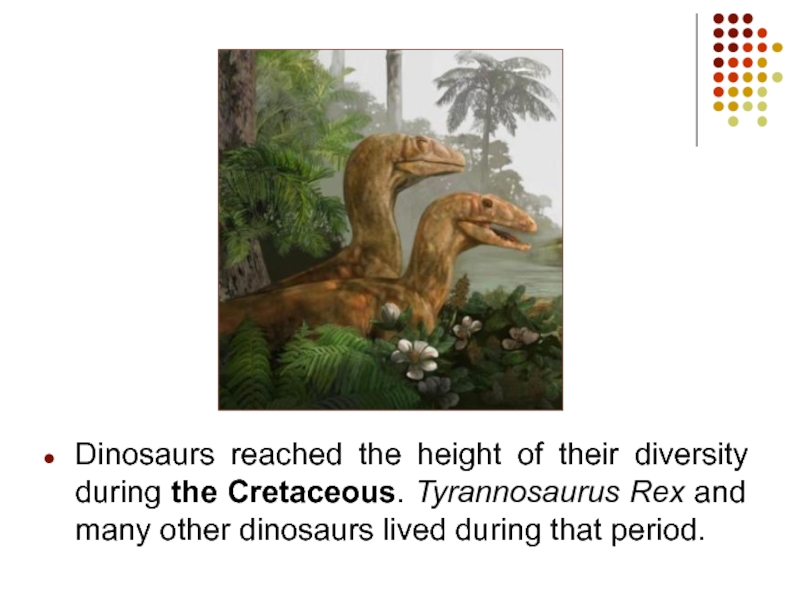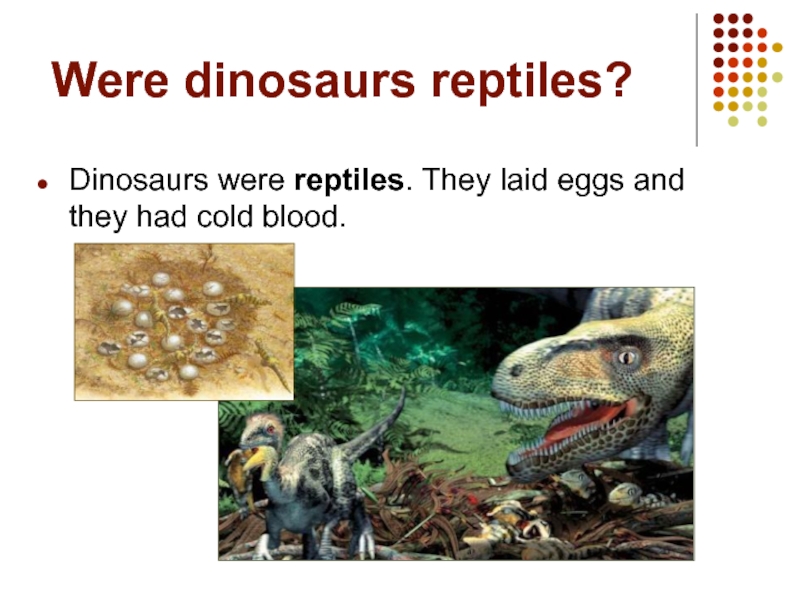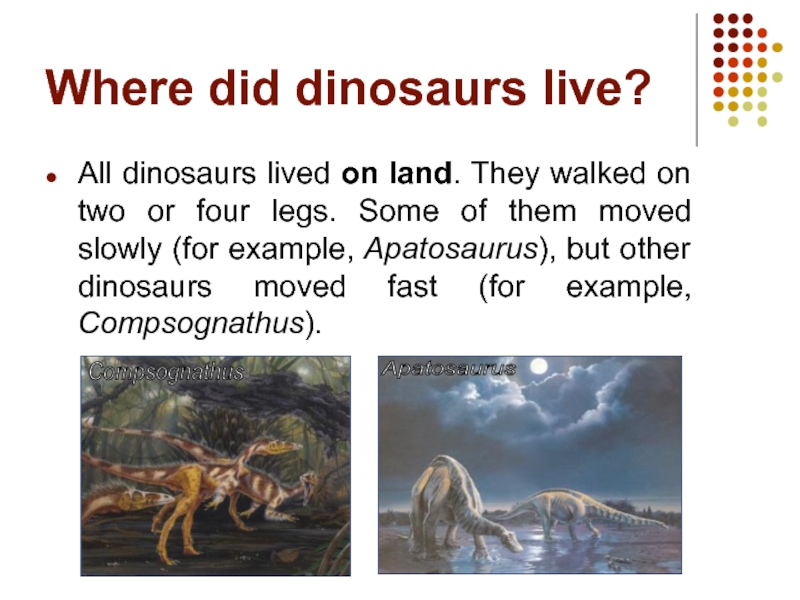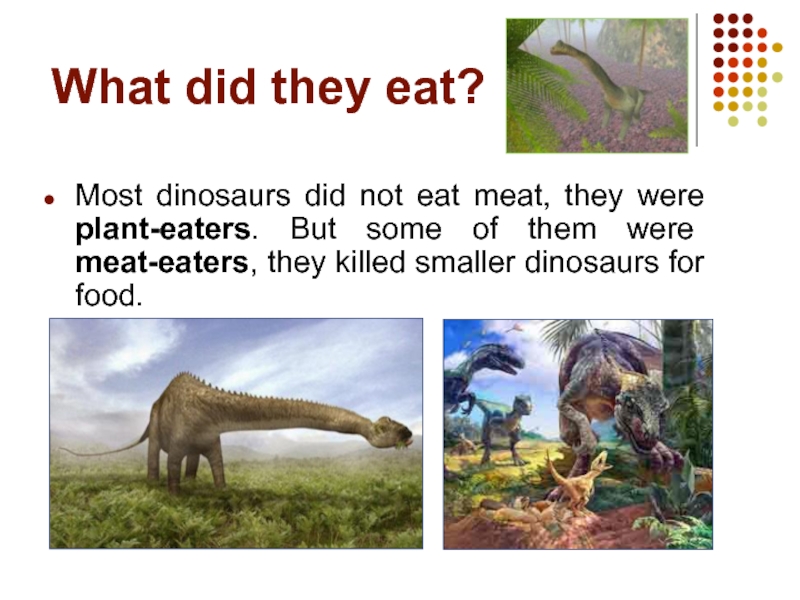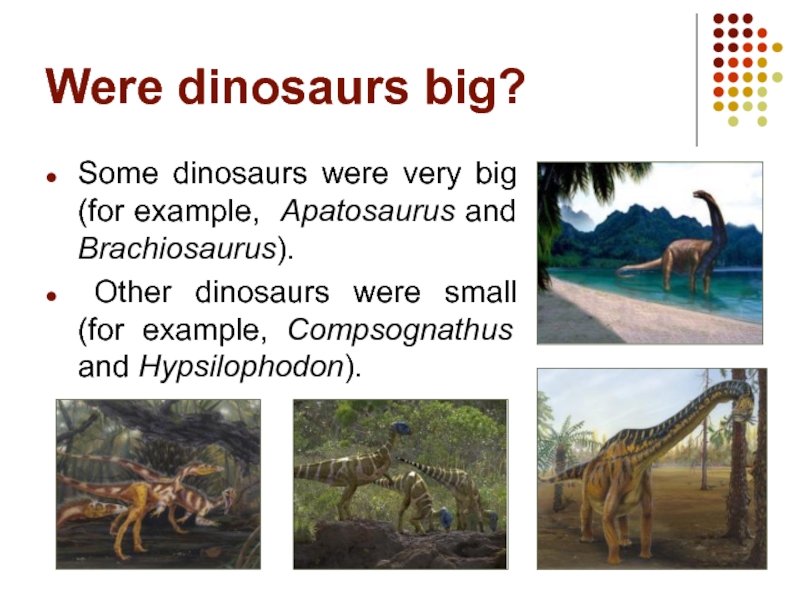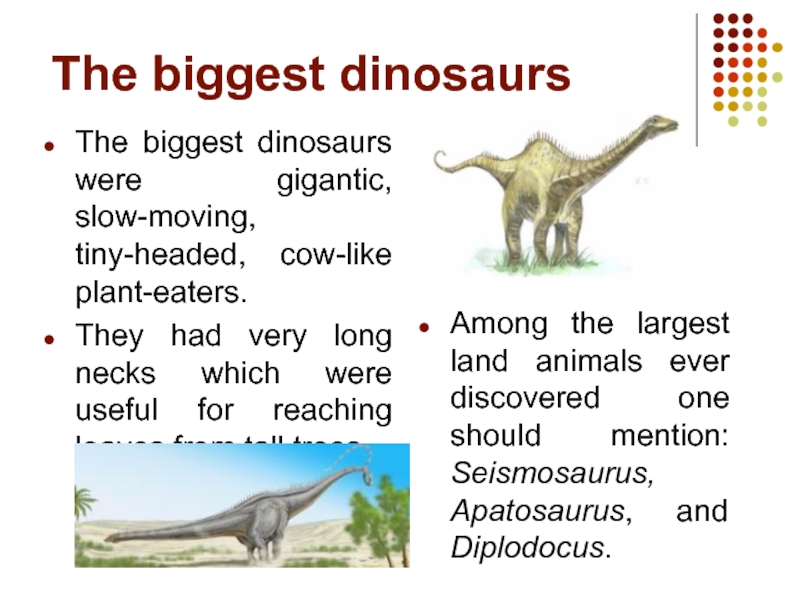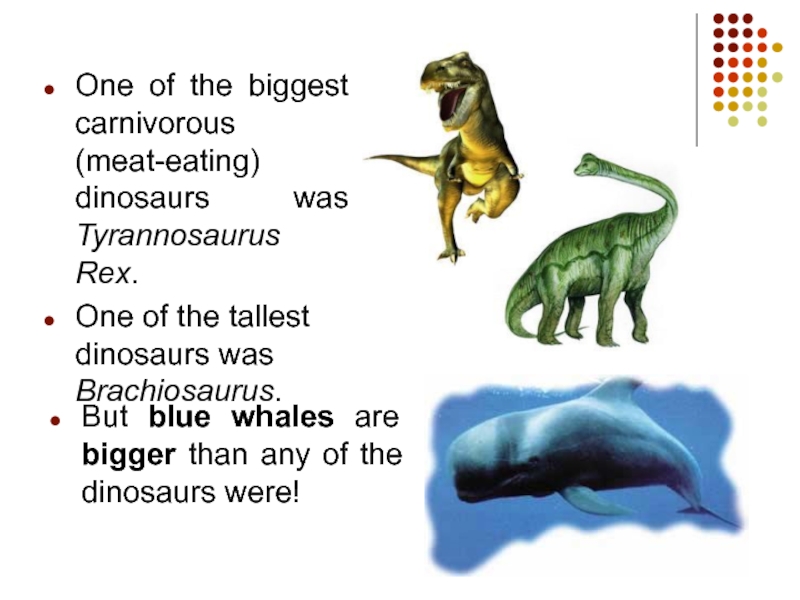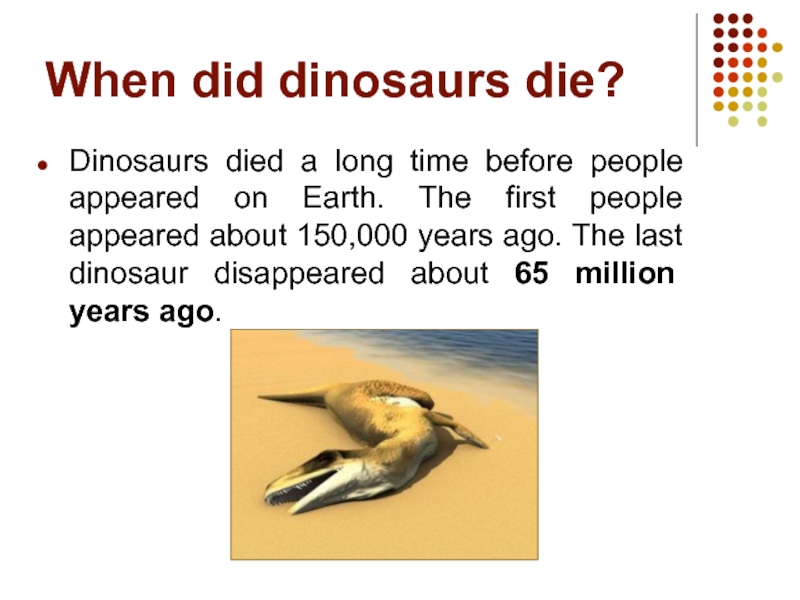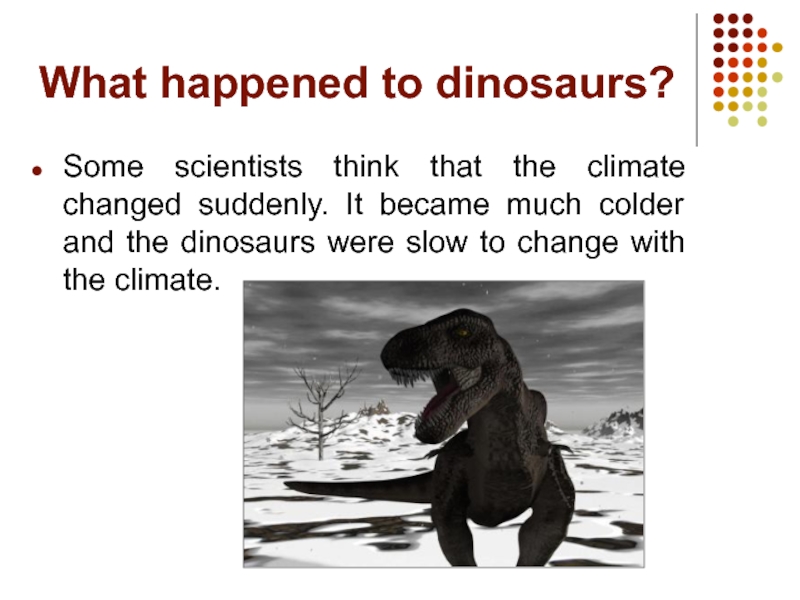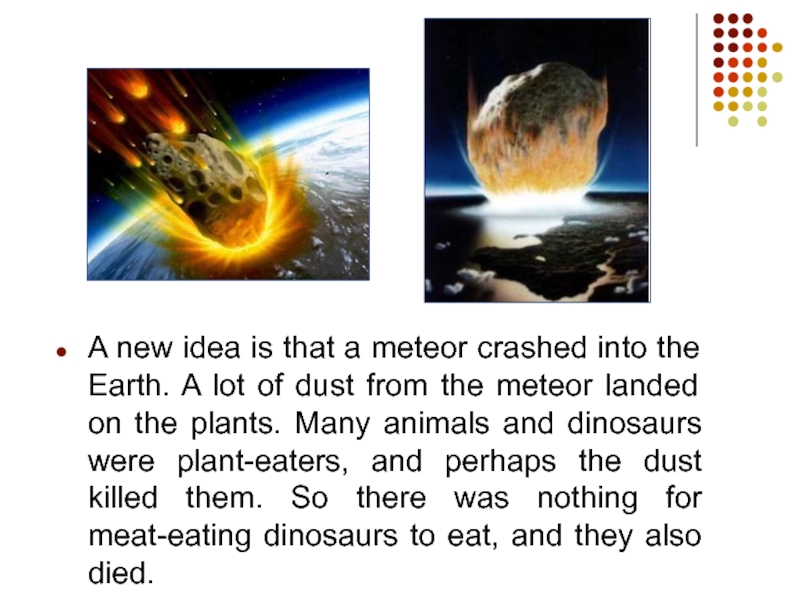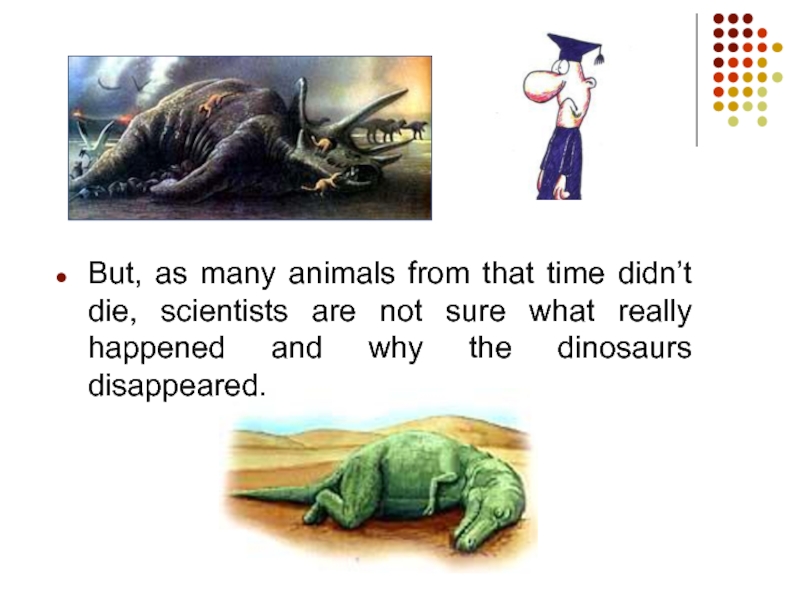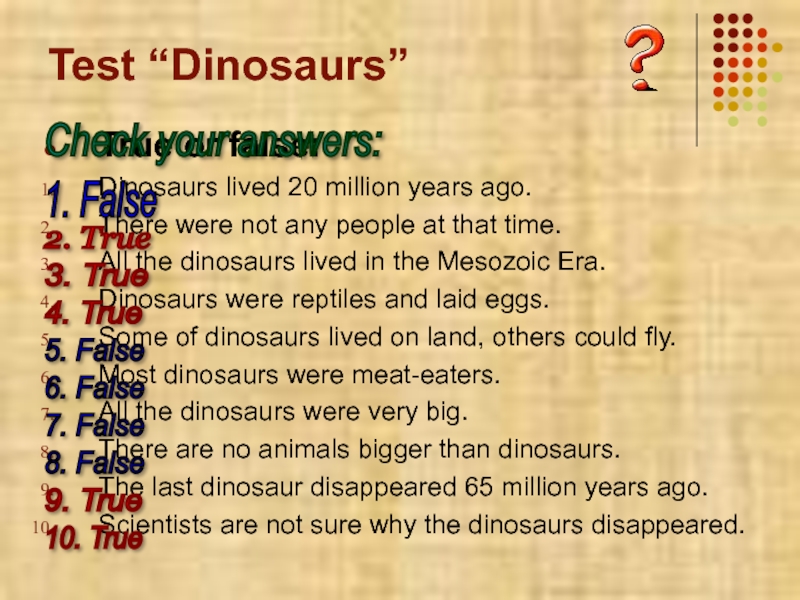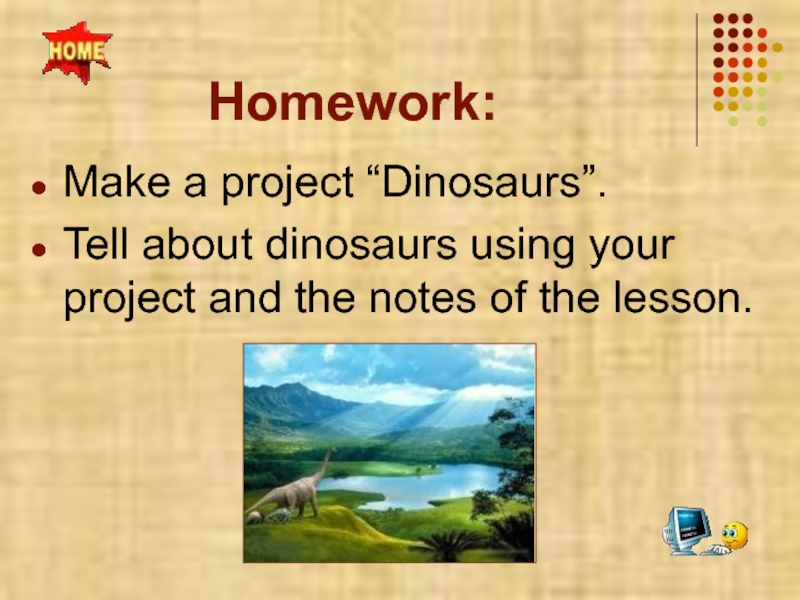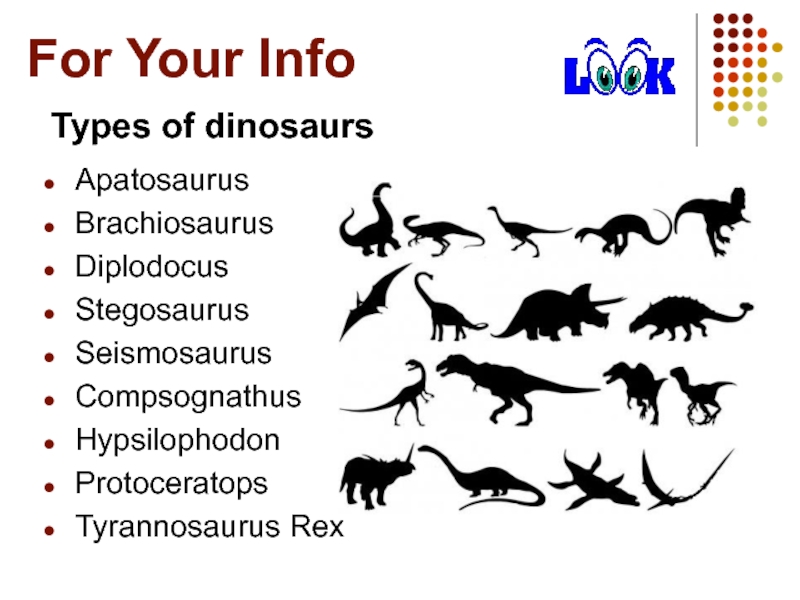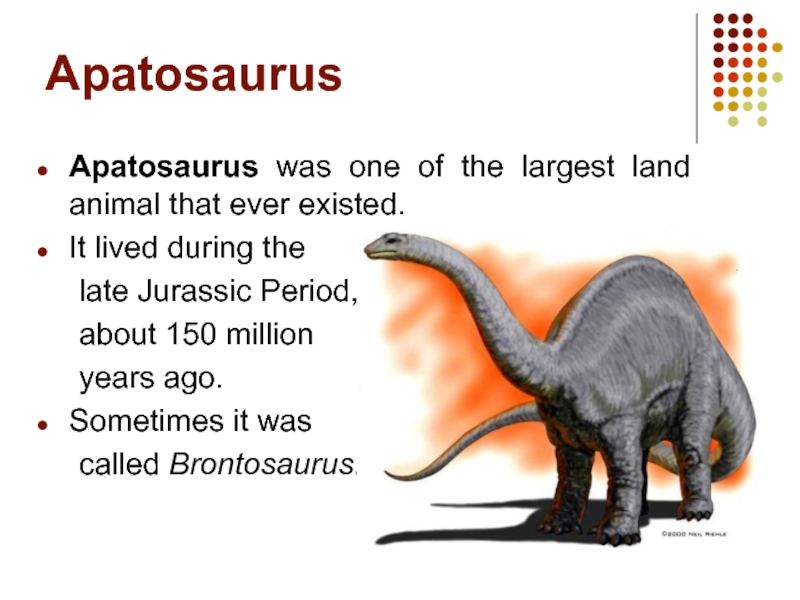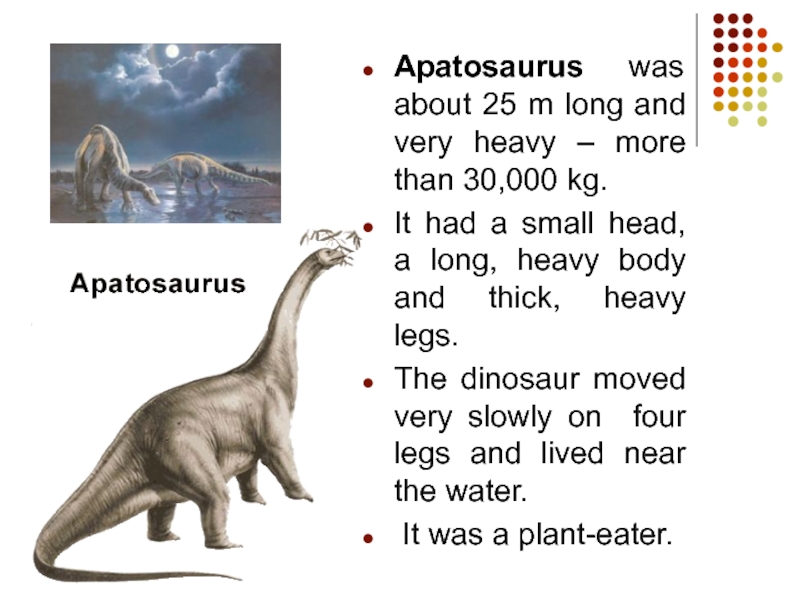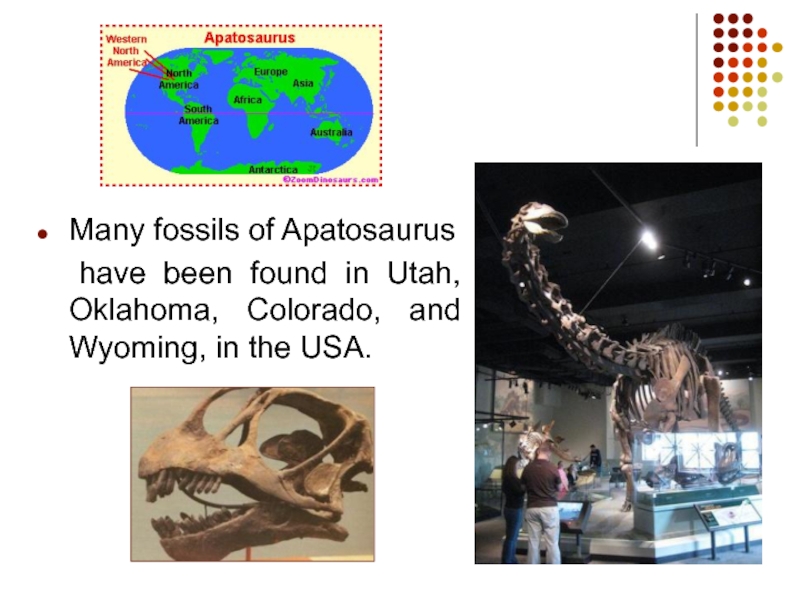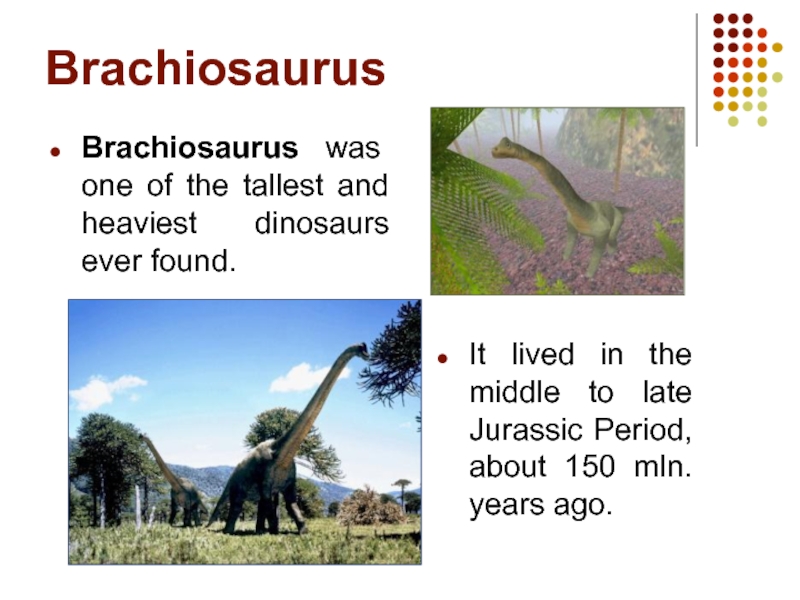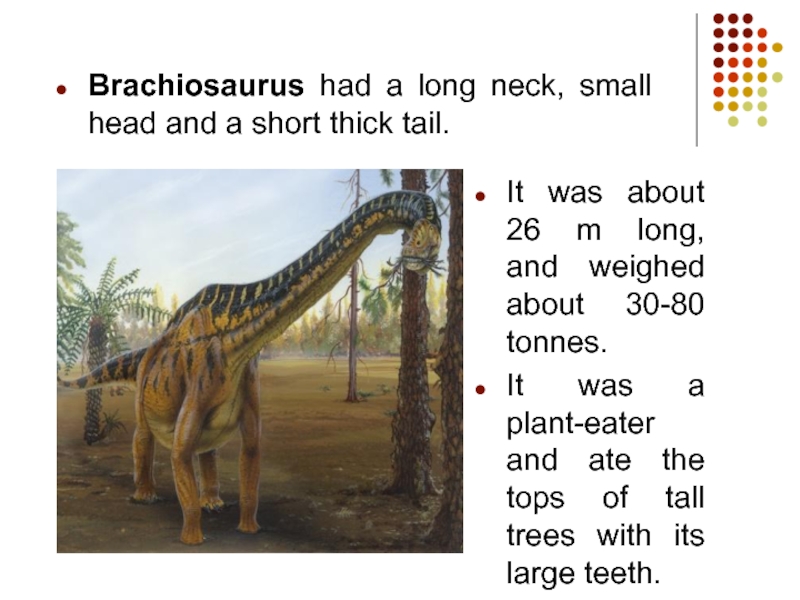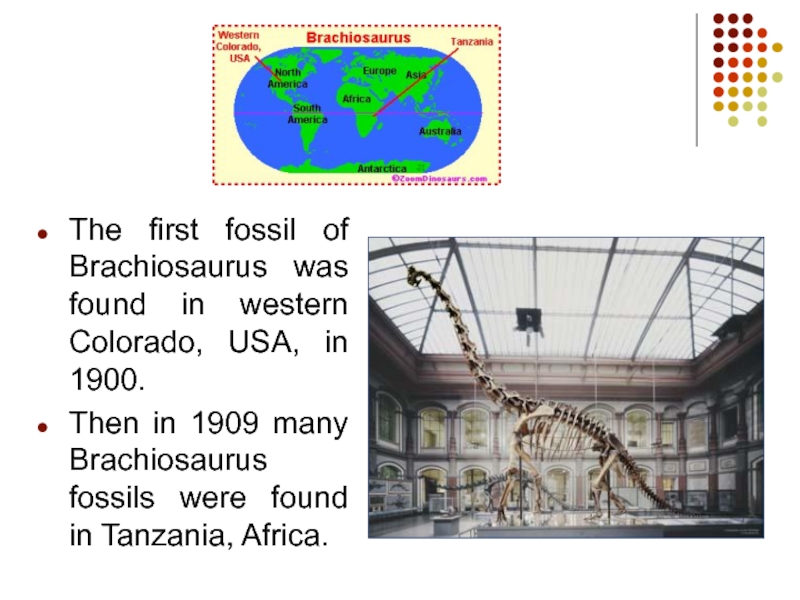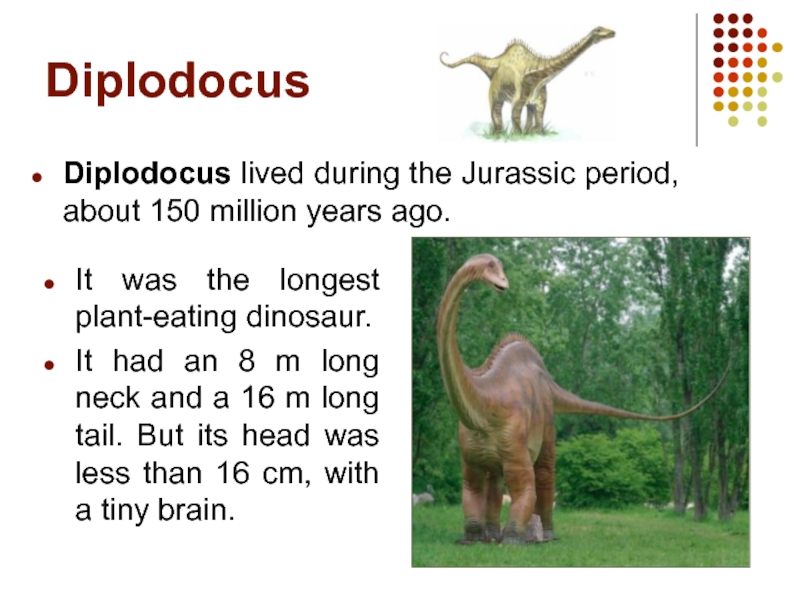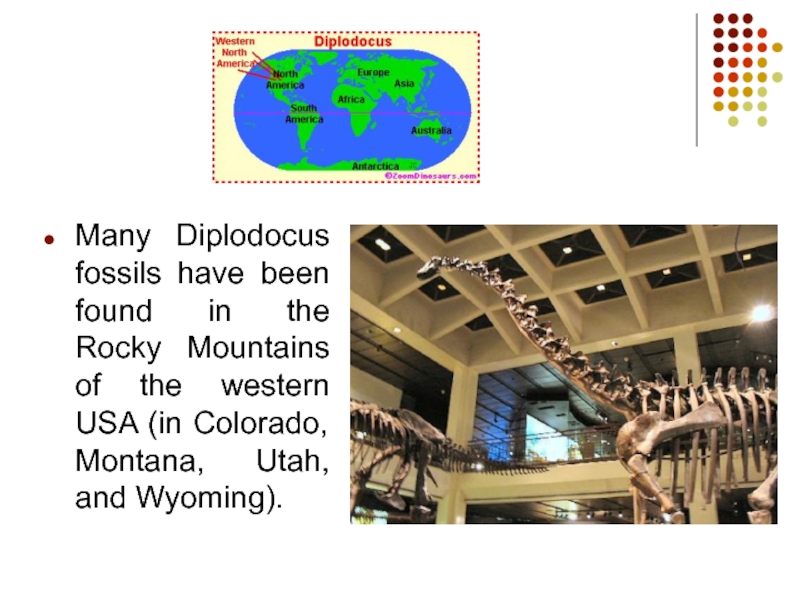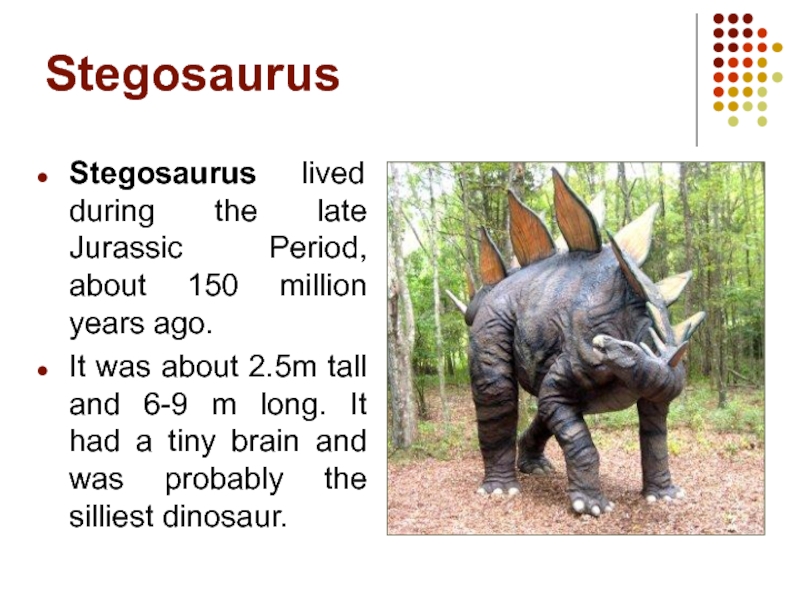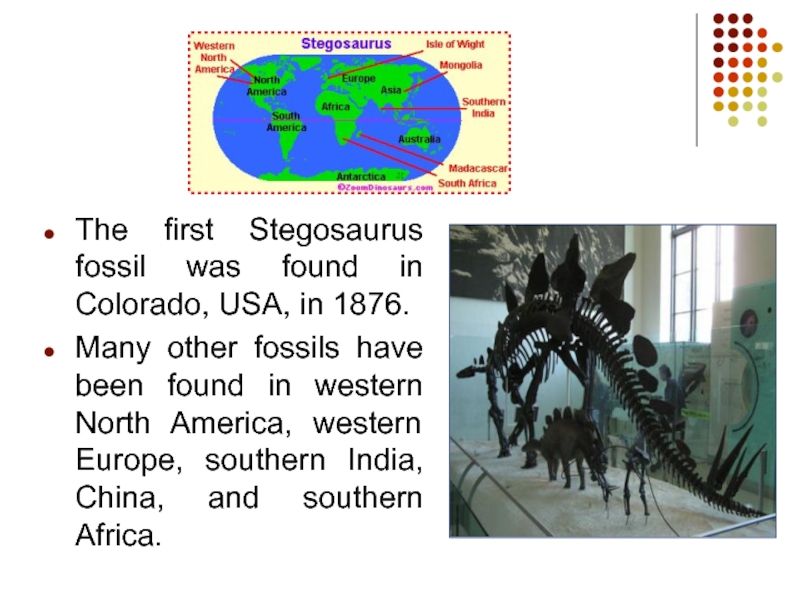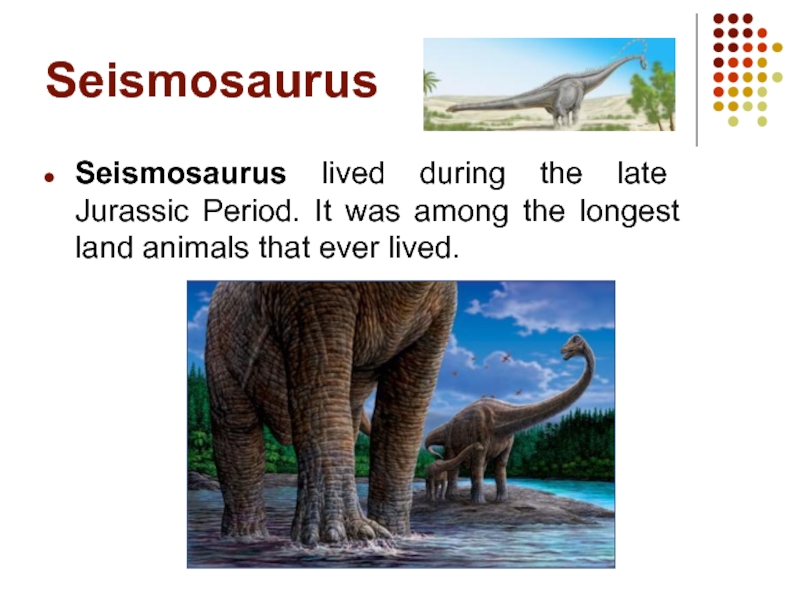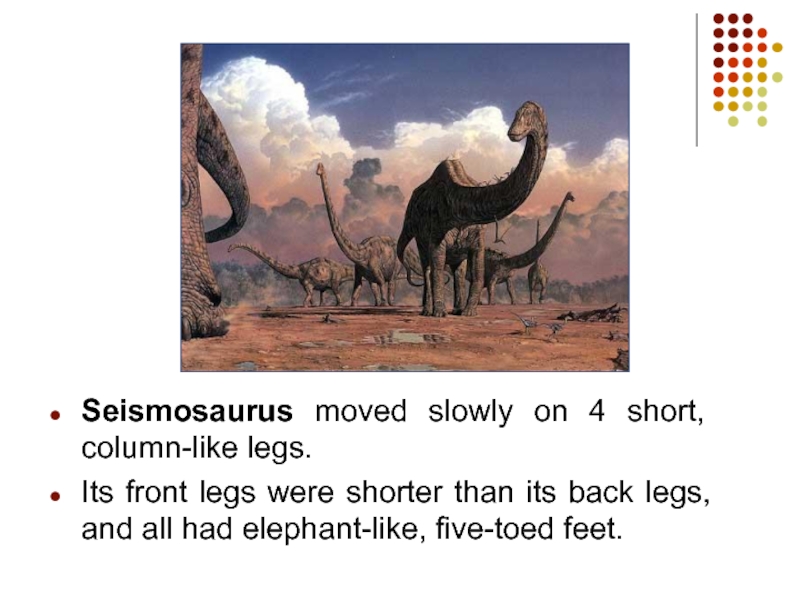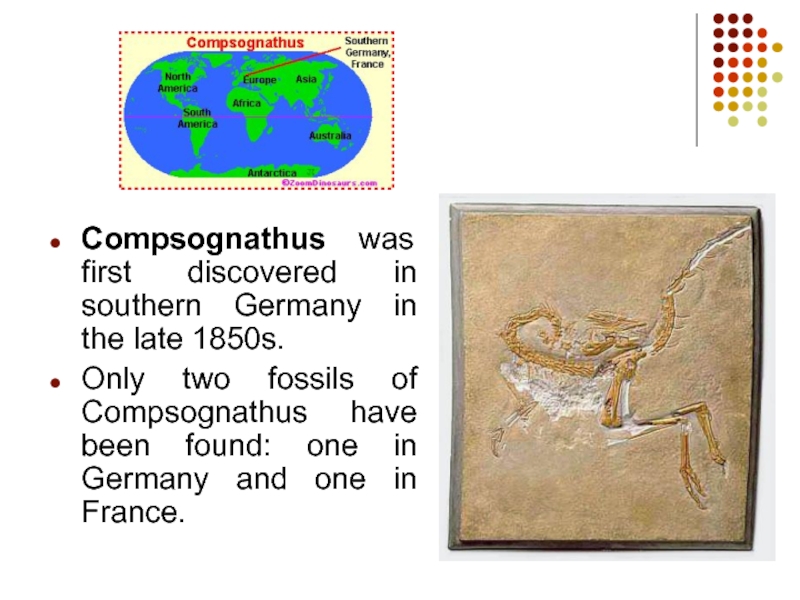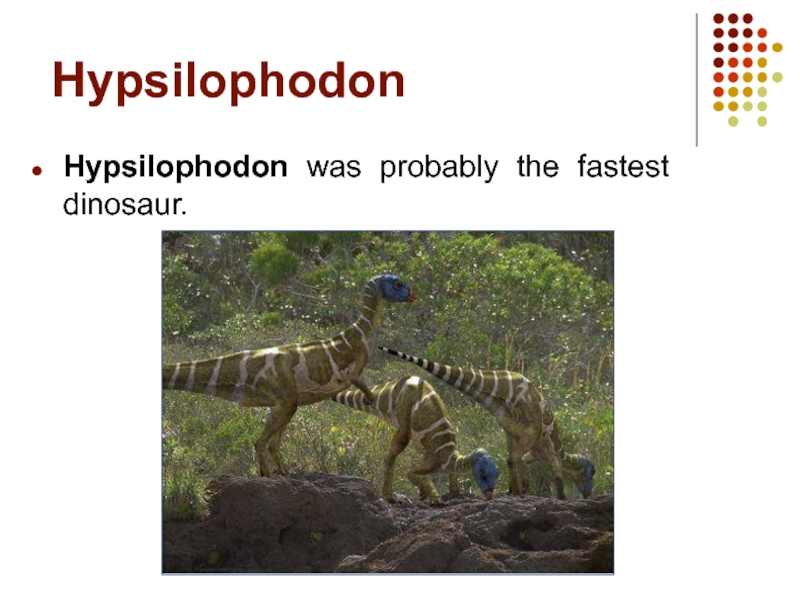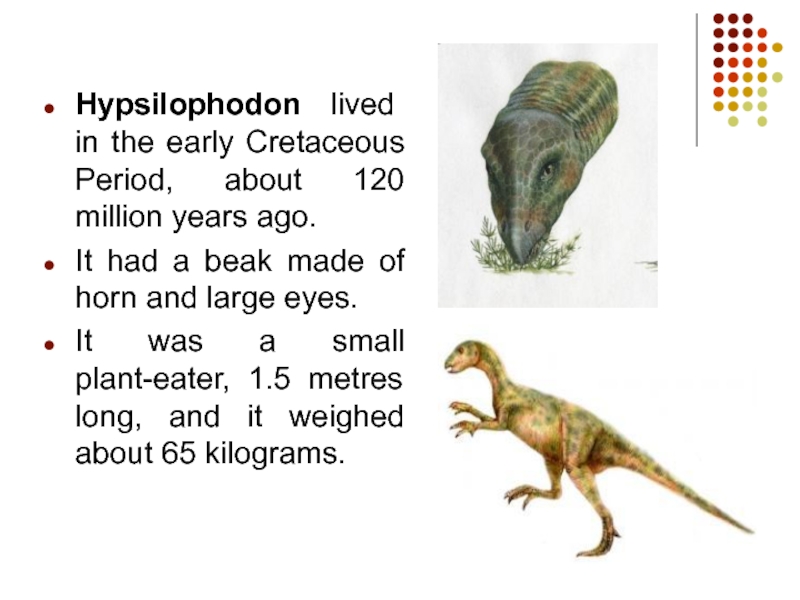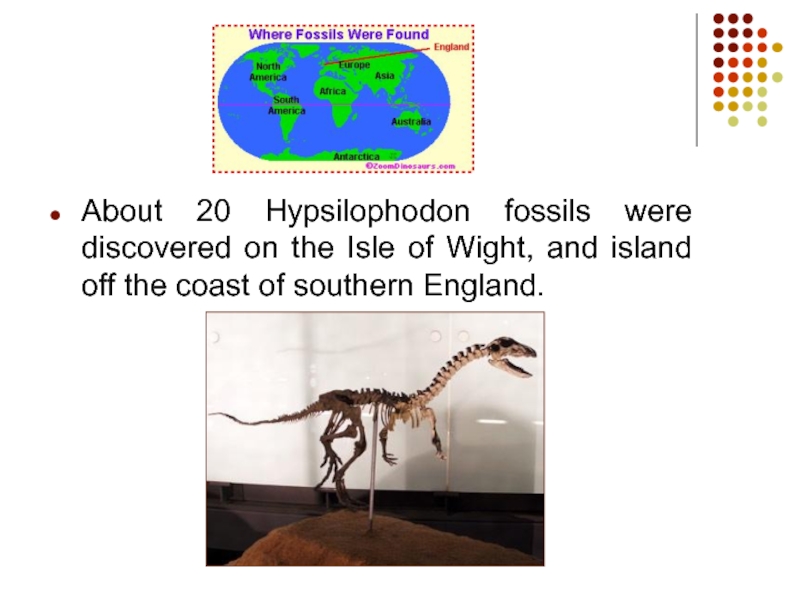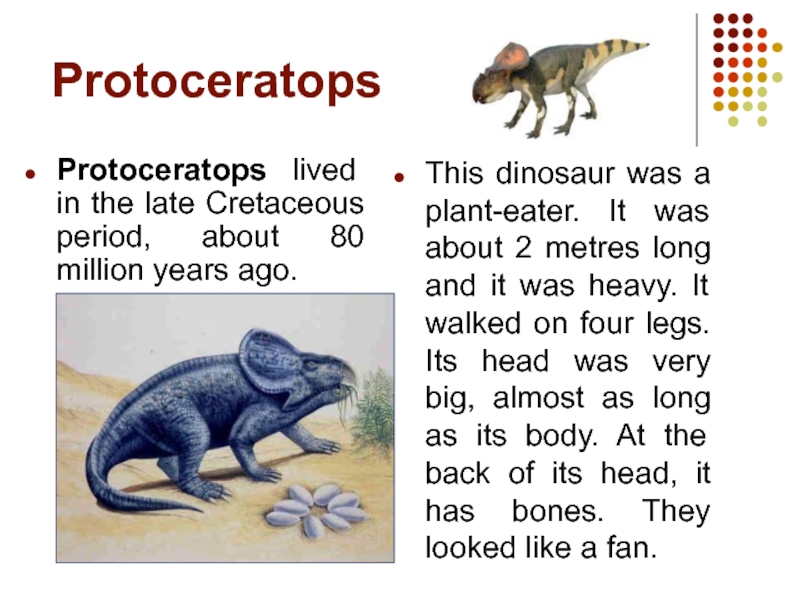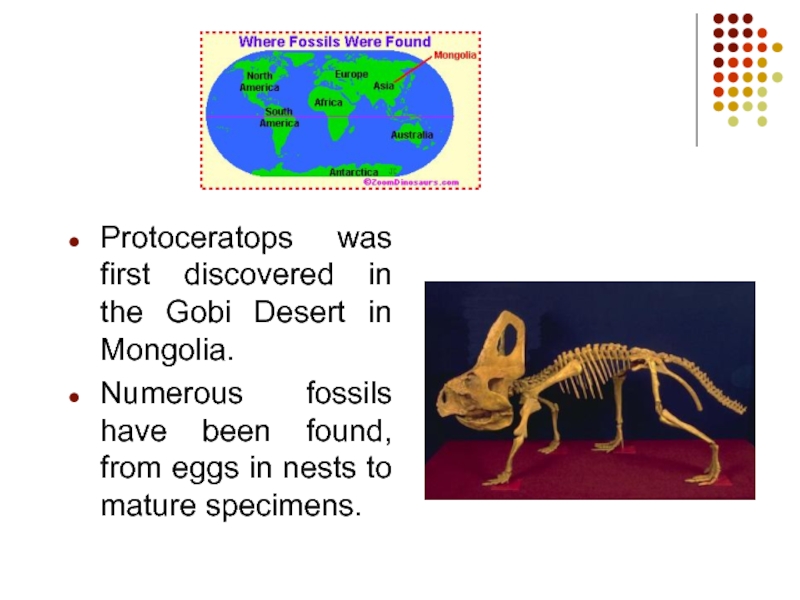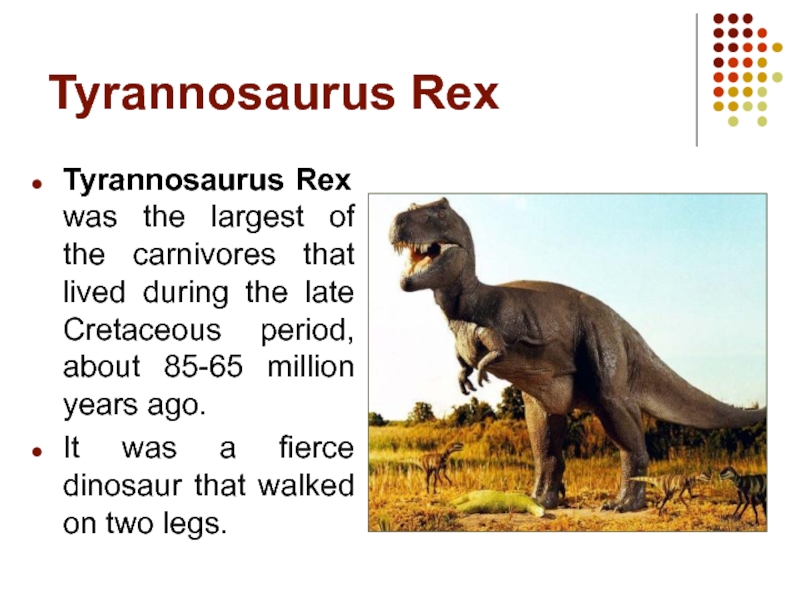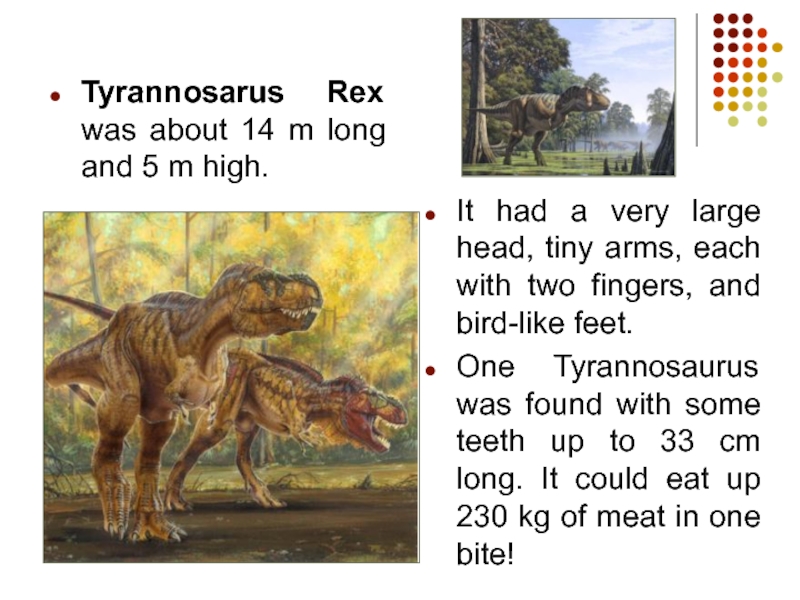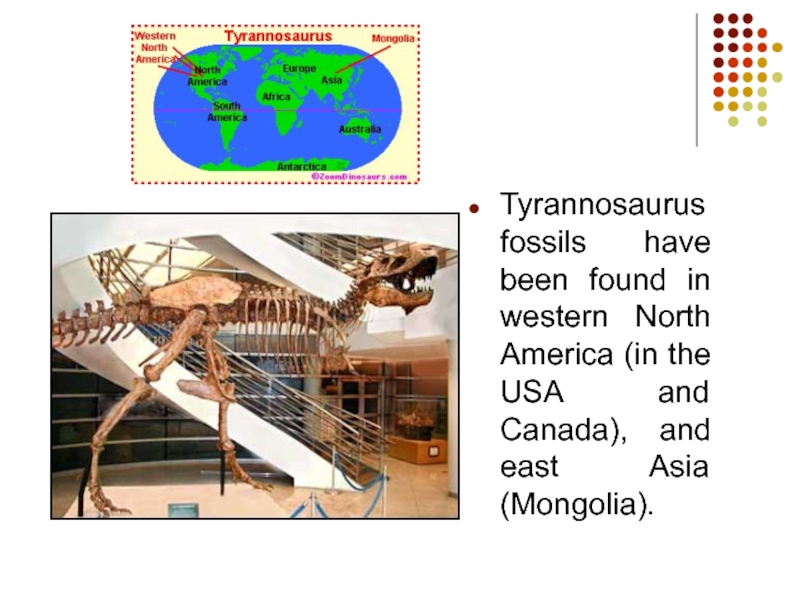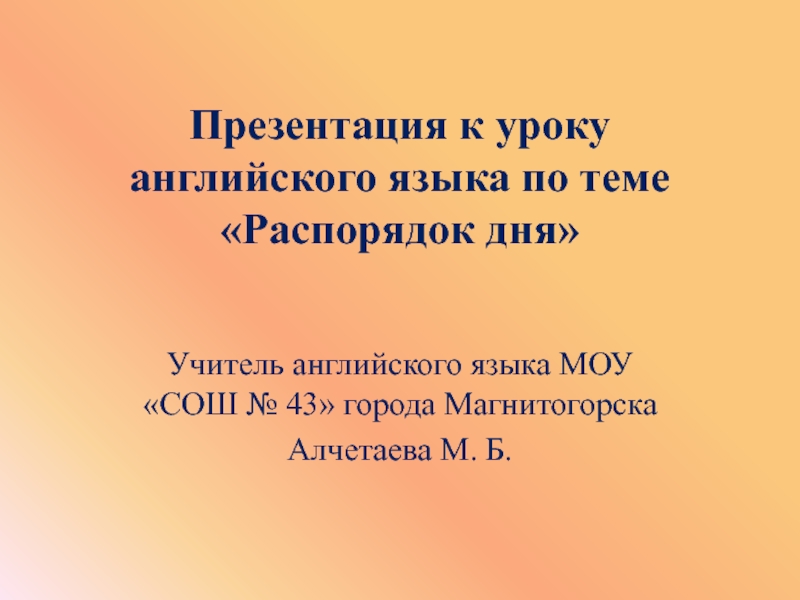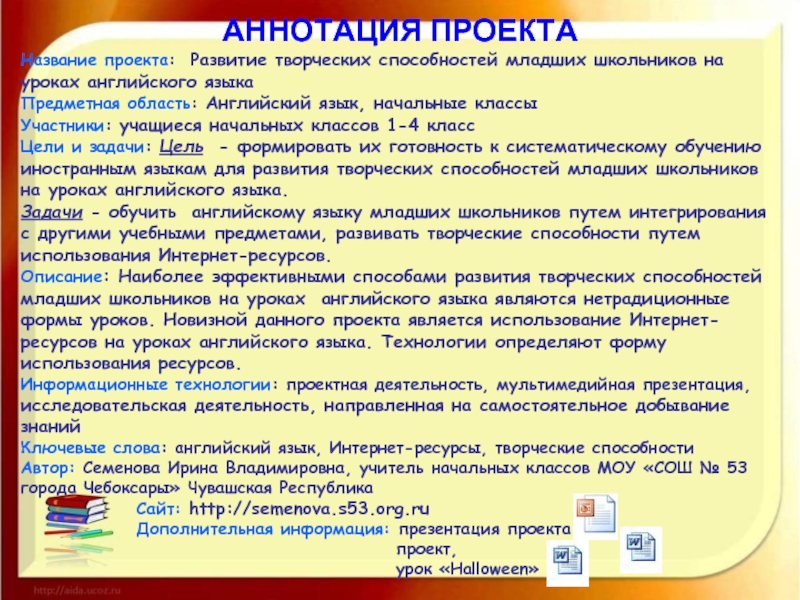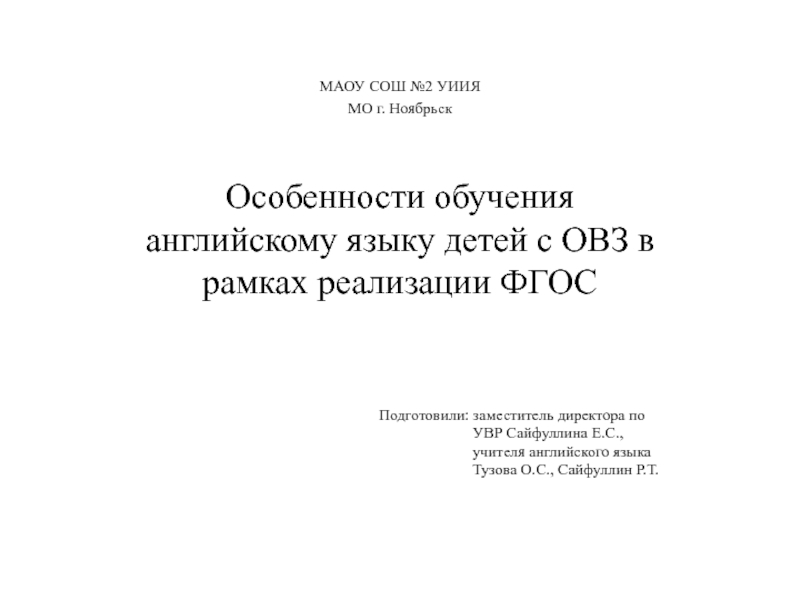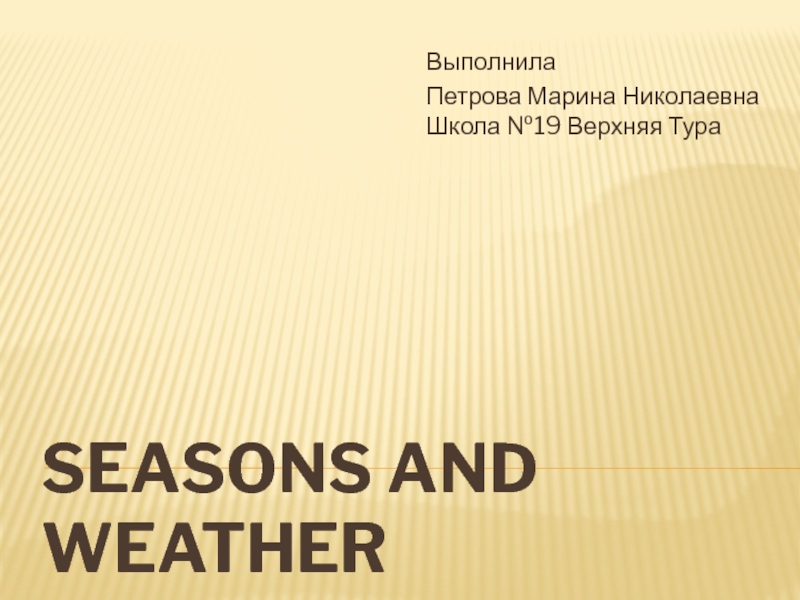Разделы презентаций
- Разное
- Английский язык
- Астрономия
- Алгебра
- Биология
- География
- Геометрия
- Детские презентации
- Информатика
- История
- Литература
- Математика
- Медицина
- Менеджмент
- Музыка
- МХК
- Немецкий язык
- ОБЖ
- Обществознание
- Окружающий мир
- Педагогика
- Русский язык
- Технология
- Физика
- Философия
- Химия
- Шаблоны, картинки для презентаций
- Экология
- Экономика
- Юриспруденция
Dinosaurs 7 класс
Содержание
- 1. Dinosaurs 7 класс
- 2. When did dinosaurs live?200 million years ago,
- 3. There were not any people on Pangaea
- 4. The dinosaurs didn’t all live at the
- 5. The Mesozoic EraThe Mesozoic is divided into
- 6. In the Triassic period of the Mesozoic,
- 7. In the Jurassic period, many new dinosaur
- 8. Dinosaurs reached the height of their diversity
- 9. Were dinosaurs reptiles?Dinosaurs were reptiles. They laid eggs and they had cold blood.
- 10. Where did dinosaurs live?All dinosaurs lived on
- 11. What did they eat?Most dinosaurs did not
- 12. Were dinosaurs big?Some dinosaurs were very big
- 13. The biggest dinosaursThe biggest dinosaurs were gigantic,
- 14. One of the biggest carnivorous (meat-eating) dinosaurs
- 15. When did dinosaurs die?Dinosaurs died a long
- 16. What happened to dinosaurs?Some scientists think that
- 17. A new idea is that a meteor
- 18. But, as many animals from that time
- 19. True or false:Dinosaurs lived 20 million years
- 20. Homework:Make a project “Dinosaurs”.Tell about dinosaurs using your project and the notes of the lesson.
- 21. For Your InfoApatosaurusBrachiosaurusDiplodocusStegosaurusSeismosaurusCompsognathusHypsilophodonProtoceratopsTyrannosaurus RexTypes of dinosaurs
- 22. ApatosaurusApatosaurus was one of the largest land
- 23. Apatosaurus was about 25 m long and
- 24. Many fossils of Apatosaurus have been found
- 25. BrachiosaurusBrachiosaurus was one of the tallest and
- 26. Brachiosaurus had a long neck, small head
- 27. The first fossil of Brachiosaurus was found
- 28. DiplodocusIt was the longest plant-eating dinosaur.It had
- 29. Many Diplodocus fossils have been found in
- 30. StegosaurusStegosaurus lived during the late Jurassic Period,
- 31. Stegosaurus walked on two legs and on
- 32. The first Stegosaurus fossil was found in
- 33. SeismosaurusSeismosaurus lived during the late Jurassic Period.
- 34. Seismosaurus moved slowly on 4 short, column-like
- 35. Seismosaurus fossils have been found in New Mexico, USA.
- 36. CompsognathusCompsognathus was a bird-like dinosaur that walked
- 37. Compsognathus was first discovered in southern Germany
- 38. HypsilophodonHypsilophodon was probably the fastest dinosaur.
- 39. Hypsilophodon lived in the early Cretaceous Period,
- 40. About 20 Hypsilophodon fossils were discovered on
- 41. ProtoceratopsProtoceratops lived in the late Cretaceous period,
- 42. Protoceratops was first discovered in the Gobi
- 43. Tyrannosaurus RexTyrannosaurus Rex was the largest of
- 44. Tyrannosarus Rex was about 14 m long
- 45. Tyrannosaurus fossils have been found in western
- 46. Sources:Andrew Littlejohn, Diana Hicks with Olga Vinogradova.
- 47. Author: Maria Stanislavovna Nickiforova, EL Teacher, School 83, Seversk, Tomsk Region
- 48. Скачать презентанцию
Слайды и текст этой презентации
Слайд 2When did dinosaurs live?
200 million years ago, there was only
one continent, called Pangaea.
It was very hot. Слайд 3There were not any people on Pangaea at that time.
Many different types of dinosaurs lived in all parts of
the world.Слайд 4The dinosaurs didn’t all live at the same time. The
different types of dinosaurs existed at different times. Dinosaur species
evolved and went extinct throughout the Mesozoic Era.Слайд 5The Mesozoic Era
The Mesozoic is divided into three time periods:
the Triassic (248-175 mln. years ago), the Jurassic (175-130 mln.
years ago), and the Cretaceous (130-65 mln. years ago).Слайд 6In the Triassic period of the Mesozoic, the early dinosaurs
were small, and most species died out in an extinction
at the end of this period.Слайд 7In the Jurassic period, many new dinosaur species appeared, including
the gigantic dinosaurs like Apatosaurus, Seismosaurus, Stegosaurus, and Brachiosaurus.
Слайд 8Dinosaurs reached the height of their diversity during the Cretaceous.
Tyrannosaurus Rex and many other dinosaurs lived during that period.
Слайд 10Where did dinosaurs live?
All dinosaurs lived on land. They walked
on two or four legs. Some of them moved slowly
(for example, Apatosaurus), but other dinosaurs moved fast (for example, Compsognathus).Apatosaurus
Compsognathus
Слайд 11What did they eat?
Most dinosaurs did not eat meat, they
were plant-eaters. But some of them were meat-eaters, they killed
smaller dinosaurs for food.Слайд 12Were dinosaurs big?
Some dinosaurs were very big (for example, Apatosaurus
and Brachiosaurus).
Other dinosaurs were small (for example, Compsognathus and
Hypsilophodon).Слайд 13The biggest dinosaurs
The biggest dinosaurs were gigantic, slow-moving, tiny-headed, cow-like
plant-eaters.
They had very long necks which were useful for
reaching leaves from tall trees. Among the largest land animals ever discovered one should mention: Seismosaurus, Apatosaurus, and Diplodocus.
Слайд 14One of the biggest carnivorous (meat-eating) dinosaurs was Tyrannosaurus Rex.
One
of the tallest dinosaurs was Brachiosaurus.
But blue whales are bigger
than any of the dinosaurs were! Слайд 15When did dinosaurs die?
Dinosaurs died a long time before people
appeared on Earth. The first people appeared about 150,000 years
ago. The last dinosaur disappeared about 65 million years ago.Слайд 16What happened to dinosaurs?
Some scientists think that the climate changed
suddenly. It became much colder and the dinosaurs were slow
to change with the climate.Слайд 17A new idea is that a meteor crashed into the
Earth. A lot of dust from the meteor landed on
the plants. Many animals and dinosaurs were plant-eaters, and perhaps the dust killed them. So there was nothing for meat-eating dinosaurs to eat, and they also died.Слайд 18But, as many animals from that time didn’t die, scientists
are not sure what really happened and why the dinosaurs
disappeared.Слайд 19True or false:
Dinosaurs lived 20 million years ago.
There were not
any people at that time.
All the dinosaurs lived in the
Mesozoic Era.Dinosaurs were reptiles and laid eggs.
Some of dinosaurs lived on land, others could fly.
Most dinosaurs were meat-eaters.
All the dinosaurs were very big.
There are no animals bigger than dinosaurs.
The last dinosaur disappeared 65 million years ago.
Scientists are not sure why the dinosaurs disappeared.
2. True
1. False
3. True
5. False
7. False
8. False
6. False
4. True
9. True
10. True
Check your answers:
Test “Dinosaurs”
Слайд 20Homework:
Make a project “Dinosaurs”.
Tell about dinosaurs using your project and
the notes of the lesson.
Слайд 21For Your Info
Apatosaurus
Brachiosaurus
Diplodocus
Stegosaurus
Seismosaurus
Compsognathus
Hypsilophodon
Protoceratops
Tyrannosaurus Rex
Types of dinosaurs
Слайд 22Apatosaurus
Apatosaurus was one of the largest land animal that ever
existed.
It lived during the
late Jurassic Period,
about 150 million
years ago.
Sometimes it was
called Brontosaurus.
Слайд 23Apatosaurus was about 25 m long and very heavy –
more than 30,000 kg.
It had a small head, a
long, heavy body and thick, heavy legs.The dinosaur moved very slowly on four legs and lived near the water.
It was a plant-eater.
Слайд 24Many fossils of Apatosaurus
have been found in Utah, Oklahoma,
Colorado, and Wyoming, in the USA.
Слайд 25Brachiosaurus
Brachiosaurus was one of the tallest and heaviest dinosaurs ever
found.
It lived in the middle to late Jurassic Period,
about 150 mln. years ago.Слайд 26Brachiosaurus had a long neck, small head and a short
thick tail.
It was about 26 m long, and weighed about
30-80 tonnes. It was a plant-eater and ate the tops of tall trees with its large teeth.
Слайд 27The first fossil of Brachiosaurus was found in western Colorado,
USA, in 1900.
Then in 1909 many Brachiosaurus fossils were
found in Tanzania, Africa.Слайд 28Diplodocus
It was the longest plant-eating dinosaur.
It had an 8 m
long neck and a 16 m long tail. But its
head was less than 16 cm, with a tiny brain.Diplodocus lived during the Jurassic period, about 150 million years ago.
Слайд 29Many Diplodocus fossils have been found in the Rocky Mountains
of the western USA (in Colorado, Montana, Utah, and Wyoming).
Слайд 30Stegosaurus
Stegosaurus lived during the late Jurassic Period, about 150 million
years ago.
It was about 2.5m tall and 6-9 m long.
It had a tiny brain and was probably the silliest dinosaur. Слайд 31Stegosaurus walked on two legs and on four legs. It
had short legs at the front and long legs at
the back.It also had triangular
‘plates’ along its back
and long spikes on the
end of its tail.
It was a plant-eater.
Слайд 32The first Stegosaurus fossil was found in Colorado, USA, in
1876.
Many other fossils have been found in western North
America, western Europe, southern India, China, and southern Africa.Слайд 33Seismosaurus
Seismosaurus lived during the late Jurassic Period. It was among
the longest land animals that ever lived.
Слайд 34Seismosaurus moved slowly on 4 short, column-like legs.
Its front legs
were shorter than its back legs, and all had elephant-like,
five-toed feet.Слайд 36Compsognathus
Compsognathus was a bird-like dinosaur that walked on two long,
thin legs.
It was probably the smallest dinosaur. It was
less than one metre long, weighed about three kilograms and moved very fast. It had a lot of sharp teeth and was a meat-eater.
It ate small animals, insects and lizards.
Слайд 37Compsognathus was first discovered in southern Germany in the late
1850s.
Only two fossils of Compsognathus have been found: one
in Germany and one in France.Слайд 39Hypsilophodon lived in the early Cretaceous Period, about 120 million
years ago.
It had a beak made of horn and large
eyes.It was a small plant-eater, 1.5 metres long, and it weighed about 65 kilograms.
Слайд 40About 20 Hypsilophodon fossils were discovered on the Isle of
Wight, and island off the coast of southern England.
Слайд 41Protoceratops
Protoceratops lived in the late Cretaceous period, about 80 million
years ago.
This dinosaur was a plant-eater. It was about
2 metres long and it was heavy. It walked on four legs. Its head was very big, almost as long as its body. At the back of its head, it has bones. They looked like a fan.Слайд 42Protoceratops was first discovered in the Gobi Desert in Mongolia.
Numerous
fossils have been found, from eggs in nests to mature
specimens.Слайд 43Tyrannosaurus Rex
Tyrannosaurus Rex was the largest of the carnivores that
lived during the late Cretaceous period, about 85-65 million years
ago.It was a fierce dinosaur that walked on two legs.
Слайд 44Tyrannosarus Rex was about 14 m long and 5 m
high.
It had a very large head, tiny arms, each with
two fingers, and bird-like feet.One Tyrannosaurus was found with some teeth up to 33 cm long. It could eat up 230 kg of meat in one bite!
Слайд 45Tyrannosaurus fossils have been found in western North America (in
the USA and Canada), and east Asia (Mongolia).
Слайд 46Sources:
Andrew Littlejohn, Diana Hicks with Olga Vinogradova. Cambridge English for
Schools in Russia. Student’s Book Two. – Cambridge University Press
and Drofa Publishers, 2004, p.16, 108.Prehistoric Animals. Журнал «Методическая мозаика». Приложение к журналу «Иностранные языки в школе». – 2008. – №1, с.11.
http://www.EnchantedLearning.com
http://www.ZoomDinosaurs.com
